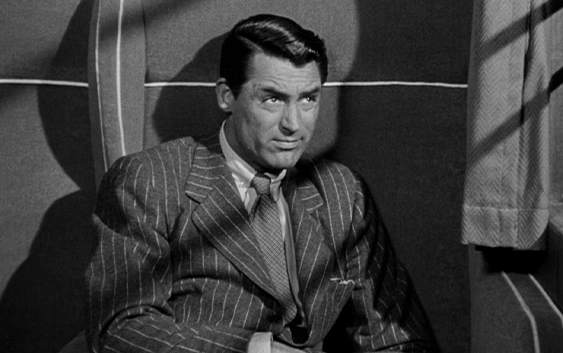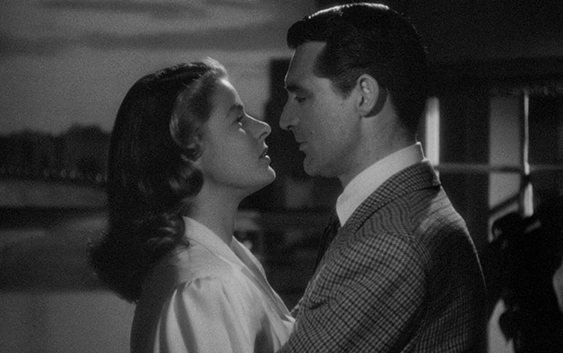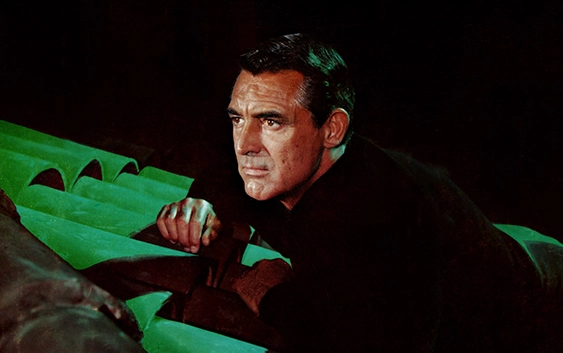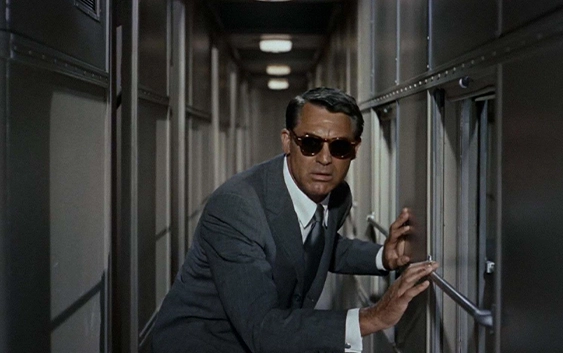Alfred Hitchcock, Cary Grant: Cinema’s Greatest Collaborations
It is somewhat terrifying to believe that Alfred Hitchcock started directing his first film, Number Thirteen, over 100 years ago in 1923. Unfortunately this film never got finished, with only a handful of scenes being filmed before financing collapsed. But Hitchcock wouldn’t give up. In 1925, the great master released his first feature film, The Pleasure Gardens. Starting here, Hitchcock became a director who, for better or worse and for all his flaws, changed the game. He presented Britain with its first ‘talkie’ in 1929 with Blackmail, constantly evolved the thriller genre, directed 1940’s Best Picture winner in Rebecca, directed the thriller that, in 2011, knocked Citizen Kane off the top spot in Sight And Sound’s Best Films of All Time list in Vertigo (1957), and made us terrified of showers and screeching violins with just a little dab of Bosco’s chocolate sauce. Not to mention, through several series of his television show, ‘Alfred Hitchcock Presents’, the filmmaker became the most recognisable silhouette on the small and big screens. He was one of the best paid directors in the business, and remains one of the most influential.
Throughout over 50 feature films, migrating from silent to sound, from Britain to Hollywood and back to Britain again, Hitchcock often returned to work with actors and actresses he’d liked. With women, this was usually the ‘Hitchcock Blonde’, with notable examples being Tippi Hedron and Grace Kelly, both of whom appeared in three Hitchcock films. The men included Peter Lorre and, perhaps his most famous collaborative partnership, with James Stewart (who appeared in Rope, The Man Who Knew Too Much, Rear Window, and Vertigo).
Perhaps his second most famous collaboration was with Stewart’s good friend, Cary Grant. Working on four films together, they established a creative partnership which would last the decades. When the American Film Institute presented Hitchcock with the Lifetime Achievement Award in 1979, just a few months before his passing, Grant was in the audience, alongside others who had been with him throughout his career.
Grant himself didn’t need Hitchcock to make a splash at the movies. By the time 1941 hit, he was already well known as a romantic leading man. Starting on screen in 1932 with This is the Night, a screwball romantic comedy in which he plays an athlete whose wife is trying to get away with another man, his charm and humour is on full display. Films such as Topper (1937), Bringing Up Baby (1938), and The Philadelphia Story (1940), would put him firmly in the spotlight as a charismatic, good looking man the producers of any film would love to cast. When Hitchcock snagged him for Suspicion in 1941, his other film that year, Penny Serenade, would earn Grant his first Oscar nomination.
Perhaps it was a mixture of all these attributes which made him such a perfect fit for the master of suspense. Hitchcock was a renowned practical joker, and many of his films are unexpectedly funny (especially for those who know Hitchcock by reputation alone). There’s almost always an element of romance, gags aplenty, and Grant’s natural charm and good looks endear any viewer to his plight as he scrambles across rooftops and the face of Mount Rushmore.
To celebrate one of the greatest partnerships in cinema, we at The Film Magazine look back at the four feature film collaborations between these two great men of Hollywood’s golden age, presenting each season of their collaboration in this, the 2nd edition of Cinema’s Greatest Collaborations.
Spring: Suspicion (1941)

The first collaboration between Alfred Hitchcock and Cary Grant was an adaptation of the novel “Before the Facts” by Anthony Berkley Cox (as ‘Francis Iles’). Pairing up the charming leading man of Cary Grant with Joan Fontaine (who won an Oscar for the role, the only acting Oscar won by an Alfred Hitchcock film), the film sees the naïve Lina McLaidlaw marrying Grant’s playboy Johnny Aysgarth. Lina soon finds out that Johnny has a reputation, gambling and cheating and borrowing and swindling, and as time goes on, she begins to suspect that he might be capable of murder, and that for her inheritance from a rich father, he might be willing to kill her, too.
It has been on record that the acting contracts of Vin Diesel and The Rock require them to never lose a fight on film to protect their tough-guy star image. Hence, very often, other situations have to be written to stop the fights from getting to a point where their characters might lose. Back in 1941, a similar issue presented itself. Grant, by now, was a romantic, charming, heart-throb of an actor, and here he is, cast in a film as a potential murderer. In the book, Lina knows he is willing to murder, and allows herself to be killed regardless, unable to act to save herself out of love for Johnny. How could one cast Cary Grant in that same role and let viewers see him as capable of such dastardliness?
And so the ending was changed, but not without Hitchcock taking issue with it and complaining about the nicer ending for the rest of his life. Nonetheless, he manages to get Grant to deliver an incredible performance. Grant’s likability here works as a weapon, the idea of him using his roguishness to hide a sinister, forceful dark side holds us captive and is a source of much of the film’s tension. The genius of this combination shows itself in a scene near the end of the film, with Johnny bringing Lina a glass of milk, which she believes may be poisoned. In the dark of the night, shadows abound, Grant in pure black, Hitchcock puts a small, unseen light inside the milk to make it glow, to draw attention to the potentially dangerous nature of the glass. Such a simple but effective scene highlights the genius of the smaller moments at the end of the film, and it could only work through the effective direction of Alfred Hitchcock and a wonderful performance by Cary Grant. Their first collaboration was a certified hit that even a studio-forced ending couldn’t diminish.
Summer: Notorious (1946)

The second collaboration between Alfred Hitchcock and Cary Grant comes in the wake of the end of the Second World War. With a director who made a name for himself in thrillers, and quite a few spy thrillers at that, this film proved to be a turning point as Hitchcock brings everything together for a more mature, considered film. One of critic Roger Ebert’s favourite films, Notorious sees Ingmar Bergman’s Alicia Huberman, daughter of a German war criminal, sent by Grant’s Mr Devlin to infiltrate a group of chemical executives hiding out in Rio, with her old flame Alexander Sebastian (Claude Rains) as the romantic hook.
Despite being billed as a noir thriller, with all the trappings intact, in actuality the film is a love triangle romance. Both Devlin and Sebastian play their charms for Alicia’s love, and it’s the back and forth between Devlin and Alicia, whether they love each other or not and how this will affect their espionage tasks, which keeps everything on tenterhooks. Grant’s usual charm is on full display, here a more serious character, duty bound and with a sly smile rather than Suspicion’s all-out devil-may-care recklessness. He perfectly encapsulates Hitchcock’s handling of the subject, always on the line between romance and danger.
That the film was essentially remade in 2002 as Mission: Impossible 2 is testament to just how well the film holds up. Its crowning achievement, a party in which Bergman and Grant sneak into a suspicious wine cellar, is set up with an outrageous yet physically affecting shot, where the camera glides from the top of landing all the way down, across the lobby and the guests, to end on a close-up of Alicia turning the key to the cellar. Down in the cellar, when the secret is revealed, the masterful use of cross-cutting and parallel narrative (which Hitchcock always exploits so well) to show the servants rapidly running out of wine and needing to go get some more, brings all that tension to the fore. It’s one of Hitchcock’s best sequences, and Grant’s playing of romantic agent, a kind of precursor to his later role in North by Northwest, is one of the best in his career.
Autumn: To Catch a Thief (1955)

The third collaboration sees Grant team up with another performer who is no stranger to the films of Alfred Hitchcock, future Princess of Monaco, Grace Kelly. Kelly had previously appeared in Rear Window and Dial M For Murder, both released the year prior in 1954. Now she’s out on the French Riviera to woo Grant’s John Robie, a retired jewel thief known as ‘the cat’. Someone’s going around pinching jewels and using Robie’s old trademarks, and so whilst evading the police he must clear his name and make sure the rich mother of Francine (Kelly) doesn’t become the latest target of the thief.
There’s something so wonderfully sumptuous about the film that makes you want to eat it with a spoon. From helicopter shots of the French Riviera to the gorgeous cinematography of Grant and Kelly in her apartment watching fireworks go off in the bay, to the beautiful technicolor Vistavision colours in the set design of the finale, every shot is a pleasure to behold. It’s a far cry from the last team-up, with Notorious being incredibly dark and suspenseful, trading in the gloomy backdrop of post-war noir for adventure and capers. To Catch a Thief still manages to get the heart racing, but in a far more relaxed and cosy way.
In many ways, this is a precursor to the final film, North by Northwest. The extravagance is here, the humour always there (especially in a memorable scene out swimming between Robie, Francine, and Danielle, played by Brigette Auber, filled with jealousy and innuendo), and Grant, though certainly criminal in capability, is Hitchcock’s famed ‘wrong man.’ Despite this, it is its own film, with its own quirks and eccentricities. Moments might not be played as seriously as they could or should be, but that’s part of the film’s charm. It’s lavish and fun and with a memorable finale, and a joy to watch from frame one to curtain call.
Winter: North by Northwest (1959)

In 1962, Alfred Hitchcock was asked if he would like to direct the first of a series of planned adaptations of the Ian Flemming “James Bond” novels, planned to be Dr. No. Hitchcock’s reply was “I’ve already made that film. It was called North by Northwest.”
Indeed, the fourth and final collaboration between Alfred Hitchcock and Cary Grant contains many elements that would become mainstays of the Bond films to come. Returning once again to the ‘wrong man’ theme Hitchcock loved to use over the years (including, of course, 1956’s The Wrong Man), the film sees Cary Grant’s Roger Thornhill, marketing executive in a cool grey suit, mistakenly identified as a secret agent known as George Caplin. Framed for the murder of a government official, he is pursued across the country by agents of a shadowy organisation, slips onto a train with a femme fatale, is attacked by crop duster, punches up suited henchman in an auction house, and has a famous fight across the face of Mount Rushmore in pursuit of valuable government secrets on a roll of microfilm. It’s action and excitement in every frame.
North by Northwest proves that Hitchcock loved humour, and it may just be his funniest film, even over more decidedly comedic films such as The Trouble with Harry. The film is riddled with jokes and innuendos (the final smash cut from Grant and his newly beloved getting into bed before cutting to a train entering a tunnel, once you see it, is magnificently and stupidly entertaining), and the choice of Cary Grant to play the lead is the perfect choice. Not only is the aforementioned grey suit considered in a 2006 poll by GQ to be the best suit in film (and influenced both Ben Affleck’s suit in Paycheck and Tom Cruise’s in Collateral), but with Grant in it, all of his previous characters in Hitchcock films are amalgamated into one. The cheeky humour of Suspicion’s Johnny is here in Thornhill’s sarcasm, the secret agent of Notorious’ Devlin is present in the later stages of Roger’s adventures, and the exotic cat-and-mouse chases of To Catch a Thief are brought to the height of excitement in the escapades of Hitchcock’s most grandiose action thriller.
North by Northwest would be the last time Cary Grant and Alfred Hitchcock would get together for a film, but the admiration for each other never seemed to fade. They left a legacy of four incredible films, each with their own unique charms and characteristics. The combination of the actor’s charm and persona as a leading man, and the director’s control of story, proves one of the greatest pairings in cinema history. Any student of film would do well not simply to study the films, but to sit back and enjoy them. Both Cary Grant and Alfred Hitchcock were entertainers, and all four films are exquisite pieces of cinema. As the years go on, one hopes future generations will relish in the joys of Suspicion, Notorious, To Catch A Thief, and North By Northwest.
Recommended for you: 10 Best Alfred Hitchcock Films

